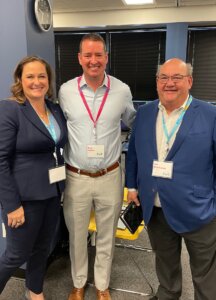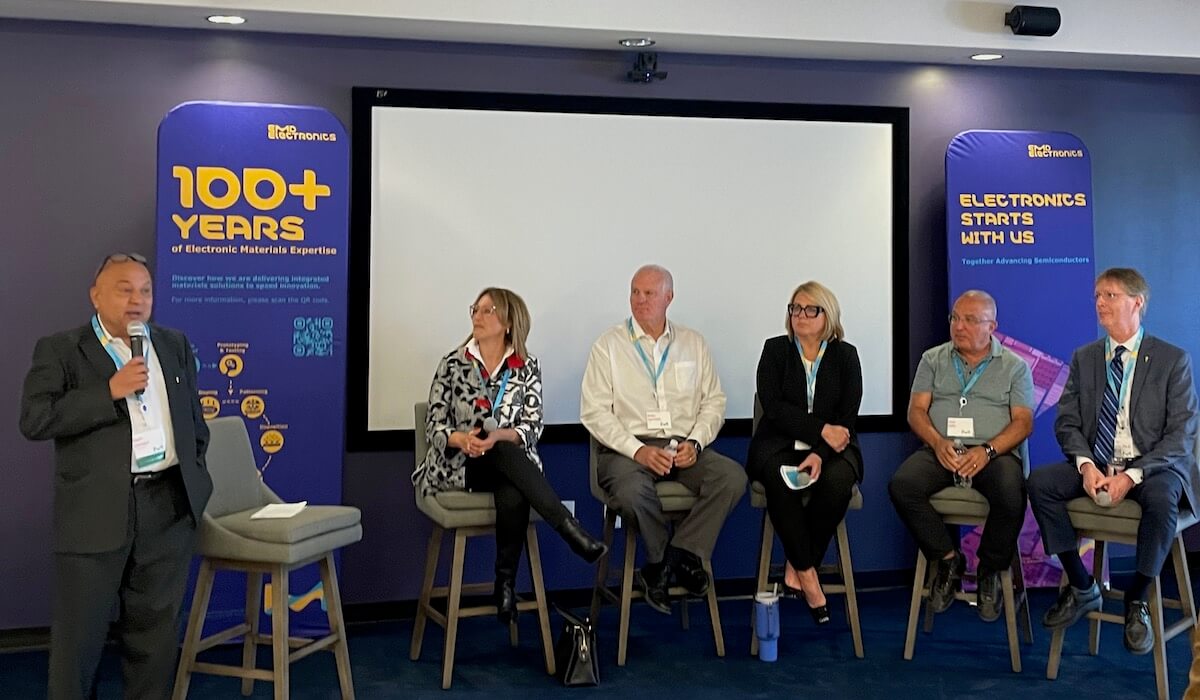Will Arizona be the nexus of innovation for U.S. semiconductor manufacturing? It certainly looks that way.
The speakers and panelists who presented at SEMI’s Arizona Breakfast Forum on May 1, confirmed what those of us who live and work here already know: The sun isn’t the only thing heating up Arizona. Whether you call it the Silicon Desert, the Semi Valley, the sixth “C”, or something completely different, all eyes are on Arizona’s semiconductor growth trajectory. And it is on fire.
Arizona aims to become a hub for semiconductor innovation, building on its history dating back to Motorola in the 1950s and Intel’s establishment in 1979. Partnerships, critical mass, market demand, supply chain innovation, infrastructure, and power are key to supporting growth.

“The state has a heart for bringing semiconductors to Arizona,” said Kate Dei Cas of EMD Electronics, which hosted the SEMI Breakfast. The company came to the East Valley originally through the acquisition of Versum Materials. The Tempe, AZ facility focuses on R&D manufacturing and small-scale start-up. in 2023 EMD opened its Delivery System and Service facility in Chandler for manufacturing sub-fab materials delivery systems.
In the past, Intel was the big draw as its suppliers, like EMD, put down roots in the desert. But it’s not just Intel or the soon-to-be TSMC gigafab that is the big draw right now (although it helps). There’s a perfect storm happening of government investment, leading-edge manufacturing, a solid supplier base, and academic engagement. From $100B investment in semiconductor projects over the past four years, and another $100M in its universities to modernize labs and develop workforce programs, Arizona is putting its money where its mouth is.
For example, Arizona State University recently announced a partnership with our member company, Deca Technologies, to establish a state-of-the-art wafer-level packaging facility.

According to Sean Fogarty of the Greater Phoenix Economic Council (GPEC), the organization has assisted 36 semiconductor companies in establishing a presence in Phoenix since 2020.
“Maricopa County is the fastest growing county in the US. Phoenix is the fifth largest city in the US, with 6M residents expected by 2033. Half of the people moving to AZ are between 18-44,” he said. That number is below the national median age and is the key workforce that the semiconductor is looking for.
Fogarty also cited growth in 40+ colleges and universities in Arizona. Arizona State University is the largest university in the U.S., with 33K engineering students currently enrolled in its Fulton School of Engineering.
Add to that a pro-business environment and a flat individual income tax of 2.5%, and it’s no wonder technology companies and younger generations are flocking here.
And it’s not just semiconductors. According to Sandra Watson of the Arizona Commerce Authority, while semiconductor companies and their supplier ecosystem provide the foundation, many related industries are also taking advantage of what Arizona has to offer – such as electric vehicle battery manufacturers, data centers, and more.
But what about power and water?
I’m glad you asked because that’s one of my concerns as well. It’s no secret that semiconductor manufacturing is one of the most resource-intensive manufacturing industries in the world. But according to SRP’s Karla Moran and APS’s Kelly Patton, Arizona’s utilities are gearing up to meet the challenge.
SRP is expanding its infrastructure to support semiconductor companies located in its service territory. It maintains reliability and power quality according to SEMI F47 requirements. And it is investing in solar and other renewables over the next five years to reduce its carbon footprint and be carbon neutral by 2050. Moran also highlighted SRPs efforts to create a resilient water supply.
For APS’s part, Patton said the company is also targeting 2050 for carbon neutrality. While its load is expected to outpace the nation driven by severe climate impact and higher population, Patton says APS plans to exit coal by 2031, and rely heavily on the Palo Verde nuclear power station as a source of clean, reliable energy. Natural gas will serve as a backup.
When it comes to water, both TSMC and Intel are already committed to conservation, with reuse and recycling baked right into their respective Green Manufacturing initiatives. According to Intel’s Aziz Safa, the company recycles 100% of the water it uses in AZ, and also inspires its suppliers to do the same. The company recently partnered with ASU to create engines for low-cost water recycling. Safa also highlighted Intel’s efforts to double power efficiency while cutting power consumption in half.
The bottom line: Watson noted that Arizona’s sustainability efforts are becoming a competitive advantage.
Collaboration is Key
Perhaps Watson and Kyle Squires, Dean of ASU’s Fulton School of Engineering said it best: The convergence of people, capabilities, and ideas along with momentum is making AZ the innovation hub.
However rapid expansion is not without its challenges. Arizona’s workforce development initiatives and unique capabilities, such as materials research and power electronics leadership, are crucial for growth.
The executive panel speakers emphasized the importance of planning for the future, streamlining regulations, and leveraging renewable energy sources to reduce costs and time. Collaborative efforts are well underway to develop and prepare the workforce for the industry, addressing challenges in talent acquisition and retention.
Silicon Fill-in-the-blank
Now that the stage is set for Arizona to become the nexus of innovation, what should we call it? We need a better name than “Silicon Desert” for the region because to me, a desert is a barren wasteland, Arizona is anything but. I’m partial to the Silicon Oasis, but I’m told that Dubai already claimed that moniker. Watson said she prefers something fresh and new rather than a rehash of Silicon-fill-in-the-blank. Squires suggested Ground Zero – but that churns up images 911, and I’m sure nobody wants that image. Any ideas?



















